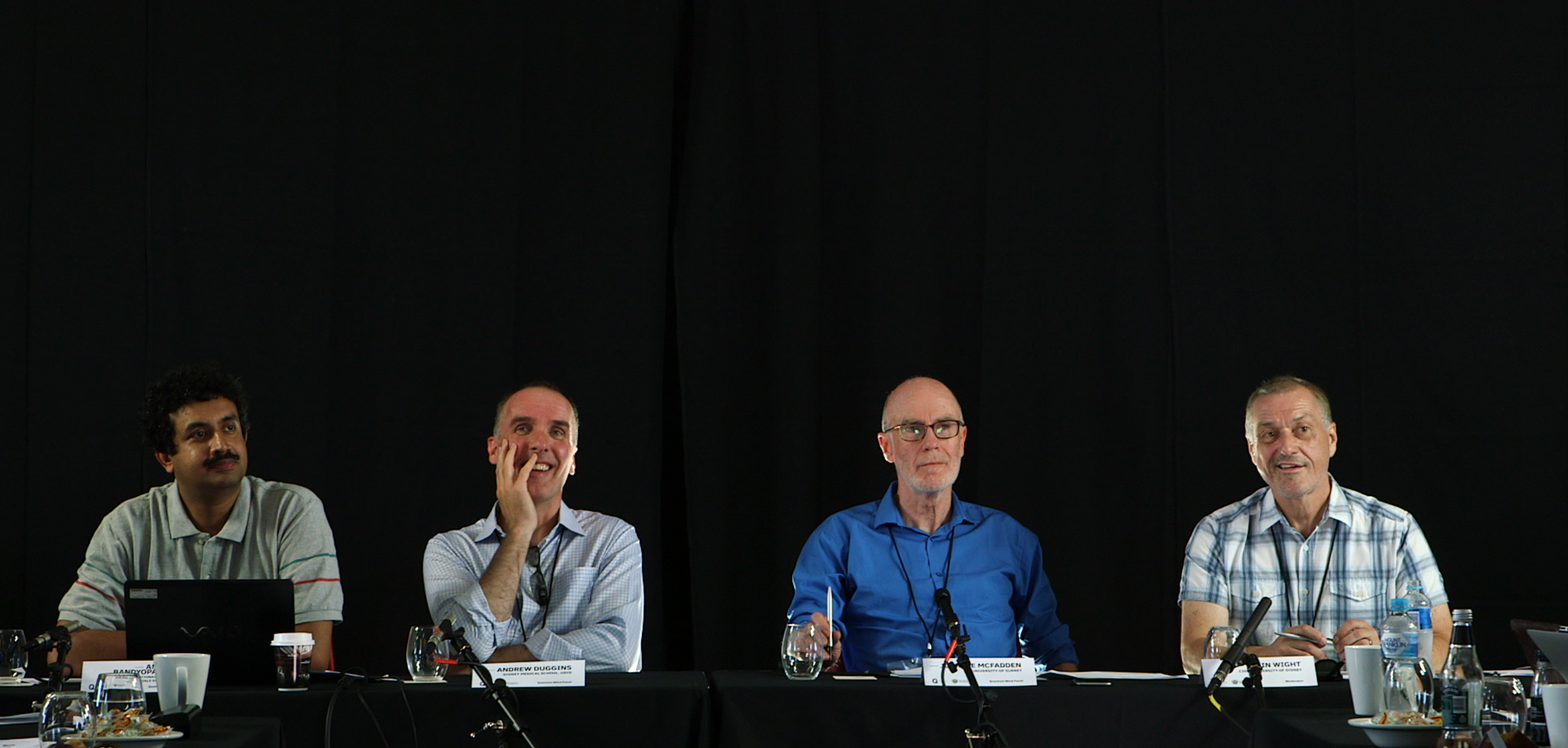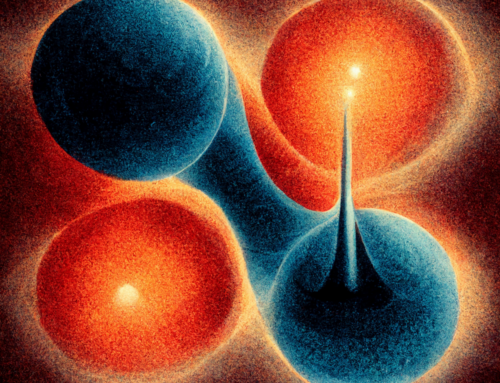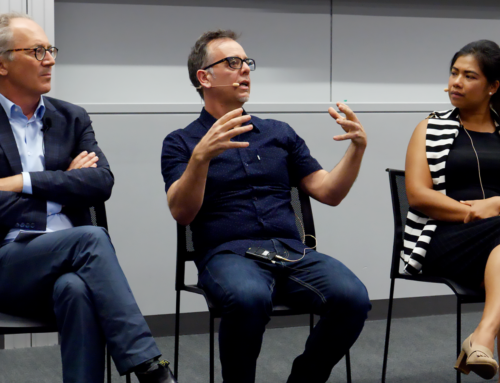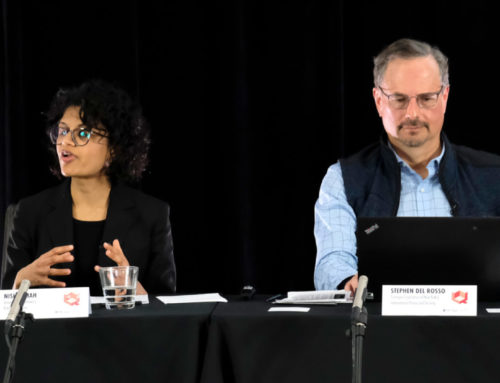Following on from the Quantum Moment and Quantum Matter panels on the previous day, Q participants gathered to contemplate the implications of quantum for the mind and consciousness, after a video lecture and Q&A with Professor Alexander Wendt on his book ‘Quantum Mind and Social Science’.
The diverse panel was comprised of materials scientist Dr Anirban Bandyopadhyay from the National Institute for Materials Science in Japan, neurologist Dr Andrew Duggins of the University of Sydney Medical School, and molecular geneticist Professor Johnjoe McFadden of the University of Surrey. The panel was moderated by international relations theorist Professor Colin Wight of the University of Sydney.
The discussion centred primarily on the nature of information processing in the brain and branched out from there to consider issues such as how consciousness might arise, the portability of quantum-level processes to the classical scale, and finally the broader implications of quantum mindedness for how we should commence the discussion on security in a quantum age.

(L-R) Dr. Andrew Duggins on the Quantum Mind panel with Professor Johnjoe McFadden and moderator Professor Colin Wight (Photo: Gilbert Bel-Bachir)
The neural network and perception
Duggins introduced the concept that each individual neuron in the brain is coded to respond to a specific experience. This experience might be a colour, a kind of motion, or even, to use his example, Halle Berry. This neural level of experience, which depends on what’s going on electrically within individual neurons at any one time, contributes in an important way to our perception of reality.
Bandyopadhyay delved into the processes within the neural network, which could determine when a neuron will fire. These processes are nested one within the other and can be thought of as clock cycles, which each cycle running faster as you descend in scale. While a neuron fires at 1 millisecond, the next nested level fires at 1 microsecond, and the final level, which resides in the nano-scale where quantum mechanical effects are apparent, fires at 2 picoseconds, or 0.000002 microseconds.
The paradox for Duggins, however, is that our experience proceeds as a smooth stream rather than as something discrete and discontinuous – the one mind, many brains paradox, which Schrödinger, better known for his dead-or-alive cat thought-experiment grappled with in Mind and Matter in 1958. How then does the mind link this vast array of neural elements into a single consciousness?
The panellists posited different theories for how to incorporate the functioning of the neural network of the brain into the experience of the mind. McFadden proposed a Gestalt field theory of consciousness, which has three propositions: that neuron firing in the brain generates an electromagnetic field; that this electromagnetic field is the seat of consciousness; and that this electromagnetic field can, in turn, affect neuron firing. Quantum wave-particle duality suggests that waves contain the information of a discrete particle, distributed in space. However, classical fields share many of these properties, such as the ability to use electro-magnetic fields (EM field) to access identical information from anywhere within the field, such as when you tune in to a radio station.
 The brain has an EM field, generated by the electrical pulses of firing neurons and McFadden proposed that it is this field which binds together the discrete, and sometimes contradictory, information of the neural network, such as observing an impossible triangle. This EM field is not only generated by neuron firing, however, it is also thought to itself affect the firing patterns of the neural network. McFadden argued that this affectation by the field on the brain gives rise to our experience of consciousness and is the source of the critical advantage that our brains have over computers, which can compute only with matter.
The brain has an EM field, generated by the electrical pulses of firing neurons and McFadden proposed that it is this field which binds together the discrete, and sometimes contradictory, information of the neural network, such as observing an impossible triangle. This EM field is not only generated by neuron firing, however, it is also thought to itself affect the firing patterns of the neural network. McFadden argued that this affectation by the field on the brain gives rise to our experience of consciousness and is the source of the critical advantage that our brains have over computers, which can compute only with matter.
Bandyopadhyay speculated that consciousness arises deep within the clock cycle of the brain, where quantum mechanics allows one element to contain two solutions, which for Bandyopadhyay would be critical for self-evaluation and improvement in any hypothetical super-intelligent machine.
Duggins also dealt with uncertainty in seeking to address the one mind, many brains paradox through the use of statistical mechanics, which links a single macro-state with any number of potential micro-states that are consistent with the properties of the macro-state, for instance, in a box filled with a gas that is free to move around within the box without affecting the overall properties of the system itself (like temperature, pressure, and size). Applying this to the mind, Duggins concluded that a probabilistic mixture of all potential neural states is the local reduction of one pure mental state of the brain, which is critical for Duggins in unifying the myriad potentialities of the brain’s incredible complexity with a single, smooth, experience of consciousness.
Bridging the quantum and the classical

Professor Johnjoe McFadden discussing quantum biology (Photo: Gilbert Bel-Bachir)
McFadden posited that life exists at the boundary between the quantum and the classical and Bandyopadhyay’s nested clock cycles provided a mechanism for which phenomena at the quantum-level can scale up to classical systems and find expression in the classical world, overcoming the quantum problem of lost coherence.
Referencing Bandyopadhyay’s work, Duggins encouraged us to look not only at the cycle within the cycle, but also for the cycle outside the cycle, and McFadden provided two real-world examples of situations where quantum mechanical principles are actively applied in macro-level systems. First, in photosynthesis, where leaves transport photons of light to a reaction centre with incredible efficiency by having a photon’s energy travel as a wave through all potential paths to find the most efficient route, demonstrating the utilisation of quantum wave-particle duality at the macro-level. Second, in the navigation of birds, where there is evidence that at least certain species of bird, such as the European robin, utilise separated yet quantum-connected particles to detect magnetic fields, demonstrating the macro-level use of quantum entanglement. (ie quantum entanglement?)
Implications

Dr. Anirban Bandyopadhyay on consciousness and AI (Photo: Gilbert Bel-Bachir)
Bandyopadhyay emphasised that in the age of quantum, we should be less concerned with the images presented by Hollywood of AI machines terrifying in both appearance and capability and more by the prospect of interference with and manipulation of the nested clock cycle of the brain. We can already interfere with brain function to a limited extent, with Duggins using the example of electrically stimulating specific areas of the brain to provoke a very specific result, such as creating the image of a coloured dot. We also know that stimuli in the form of different music can alter cognitive function – the music that tamed the savage beast. Refining a process of interference in the clock cycle could conceivably change someone’s mind, potentially without their knowledge of the intervention, with potentially profound consequences. This was of particular interest to Q participants and it was suggested that the exploration of the ethical implications was needed – was it justified, for example, to utilise such technology to change the mind of a terrorist?
A greater understanding about how our own minds process information and create knowledge could also lead to breakthroughs in the creation of an artificial mind, as opposed to a very fast yet unconscious computer. There was acknowledgment that there are differing opinions as to the role that quantum computers will play and whether we need to learn how to ask computers questions in a different manner, rather than simply further speeding up processing.
The Quantum Mind panel raised significant questions for Q participants about our knowledge of how the mind – our only window into the operation of the world around us – actually works, and the benefits and risks of furthering that knowledge. Such developments have the potential to fundamentally reshape the world that we inhabit and the discussion highlighted the need for the social sciences to grapple with these issues now, before the physical sciences deliver the capabilities.
Benjamin Sara is a Project Q Research Assistant, holds a Master of Arts (International Studies) from the University of Adelaide, and is a PhD candidate at the University of Sydney’s Centre for International Security Studies.







Leave a Reply